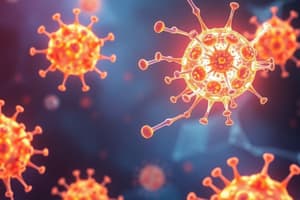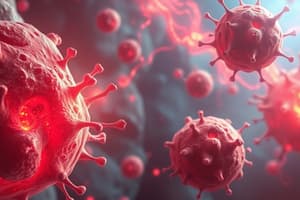Podcast
Questions and Answers
What is the primary function of C3b in the complement system?
What is the primary function of C3b in the complement system?
- Initiate inflammation
- Trigger fever response
- Promote antibody production
- Act as an opsonin for phagocytosis (correct)
Which pathway of complement activation does not require antibodies?
Which pathway of complement activation does not require antibodies?
- Classical pathway
- C3 convertase pathway
- Alternative pathway (correct)
- Lectin pathway
What role does C5a play in the inflammatory process?
What role does C5a play in the inflammatory process?
- Inhibits neutrophil migration
- Promotes apoptosis in infected cells
- Stimulates histamine release from mast cells (correct)
- Decreases vascular permeability
What characterizes serous inflammation?
What characterizes serous inflammation?
Which regulatory protein is crucial for preventing excessive complement activation?
Which regulatory protein is crucial for preventing excessive complement activation?
What is a common outcome of untreated acute inflammation?
What is a common outcome of untreated acute inflammation?
How does the membrane attack complex (MAC) lead to cell death?
How does the membrane attack complex (MAC) lead to cell death?
What is a defining feature of fibrinous inflammation?
What is a defining feature of fibrinous inflammation?
What morphological change is typical during acute inflammation?
What morphological change is typical during acute inflammation?
Which type of inflammation involves necrotic tissue sloughing?
Which type of inflammation involves necrotic tissue sloughing?
What is the main risk associated with deficiency of the terminal components of complement?
What is the main risk associated with deficiency of the terminal components of complement?
What does the presence of high levels of C3a indicate in an inflammatory response?
What does the presence of high levels of C3a indicate in an inflammatory response?
What condition can result from a deficiency in Factor H?
What condition can result from a deficiency in Factor H?
In which type of inflammation is the exudate primarily composed of neutrophils and cellular debris?
In which type of inflammation is the exudate primarily composed of neutrophils and cellular debris?
Which mediator is primarily responsible for vasodilation and increased permeability of venules during acute inflammation?
Which mediator is primarily responsible for vasodilation and increased permeability of venules during acute inflammation?
What is the main role of arachidonic acid metabolites in inflammation?
What is the main role of arachidonic acid metabolites in inflammation?
Which cytokine is notably involved in causing fever during the acute inflammatory response?
Which cytokine is notably involved in causing fever during the acute inflammatory response?
What outcomes can result from acute inflammation?
What outcomes can result from acute inflammation?
Which of the following cytokines is primarily involved in the recruitment of neutrophils?
Which of the following cytokines is primarily involved in the recruitment of neutrophils?
What is the function of lipoxins during the inflammatory process?
What is the function of lipoxins during the inflammatory process?
What do leukotrienes primarily influence during acute inflammation?
What do leukotrienes primarily influence during acute inflammation?
Which component of the complement system increases vascular permeability and aids in chemotaxis?
Which component of the complement system increases vascular permeability and aids in chemotaxis?
Which type of inflammation is characterized by the presence of pus?
Which type of inflammation is characterized by the presence of pus?
Which pharmacologic agents are known to inhibit both cyclooxygenase-1 and cyclooxygenase-2?
Which pharmacologic agents are known to inhibit both cyclooxygenase-1 and cyclooxygenase-2?
What is the role of chemokines in the inflammation process?
What is the role of chemokines in the inflammation process?
Which mediator is primarily derived from plasma-derived inactive precursors activated during inflammation?
Which mediator is primarily derived from plasma-derived inactive precursors activated during inflammation?
Which of the following is not considered a classical mediator of inflammation?
Which of the following is not considered a classical mediator of inflammation?
Which mediator is associated with promoting the systemic acute-phase response during inflammation?
Which mediator is associated with promoting the systemic acute-phase response during inflammation?
Flashcards are hidden until you start studying
Study Notes
Mediators of Inflammation
- Inflammation is initiated and regulated by various substances called mediators.
- Key mediators: histamine, prostaglandins, leukotrienes, cytokines (TNF, IL-1, IL-6), chemokines, platelet-activated factor, complement, and kinins.
- Origin: Produced locally by cells at the site of inflammation or derived from circulating inactive precursors that are activated at the site.
- Activation: Triggered by microbial products and substances released by necrotic cells.
- Short-lived: Quickly decay, inactivated by enzymes, or scavenged, or inhibited.
- Interconnected: One mediator can stimulate the release of others, amplifying or counteracting the initial action.
Vasoactive Amines: Histamine
- Found in mast cells, basophils, and platelets.
- Released by degranulation in response to physical injury, antibody binding, complement products, and neuropeptides.
- Effects: Dilation of arterioles and increased permeability of venules.
- Antagonists: H1 receptor antagonists are used to treat inflammatory reactions, such as allergies.
Vasoactive Amines: Serotonin
- Present in platelets and neuroendocrine cells in the gastrointestinal tract.
- Functions: Neurotransmitter in the GI, vasoconstrictor.
Arachidonic Acid Metabolites
- Produced from arachidonic acid present in membrane phospholipids.
- Stimulate: Vascular and cellular reactions in acute inflammation.
- Released: By activated phospholipases, mainly PLA2.
- Conversion: Rapidly convert to bioactive mediators called eicosanoids, synthesized by cyclooxygenases and lipoxygenases.
Prostaglandins (PGs)
- Produced by mast cells, macrophages, endothelial cells, and other cells.
- Involved in vascular and systemic reactions of inflammation.
- Generated by: Two cyclooxygenases (COX-1 and COX-2).
- COX-2: Induced by inflammatory stimuli, generates PGs involved in inflammatory reactions and is low/absent in normal tissues.
- Important PGs: PGE2, PGD2, PGF2a, PGI2 (Prostacyclin), and TXA2 (thromboxane A2)
- Actions: Vasodilation, increased permeability, chemoattractant, platelet aggregation, vasoconstriction, inhibition of platelet aggregation.
Leukotrienes
- Produced in leukocytes and mast cells by the action of lipoxygenase.
- Involved in vascular and smooth muscle reactions and leukocyte recruitment.
- LTB4: Chemotactic agent, activator of neutrophils, aggregation and adhesion, generation of ROSs, release of lysosomal enzymes.
- LTC4, LTD4, and LTE4: Vasoconstriction, bronchospasm, increased permeability of venules.
Lipoxins
- Generated from AA by lipoxygenase pathway.
- Suppression of inflammation: By inhibiting leukocyte recruitment, neutrophil chemotaxis, and adhesion to endothelium.
Pharmacologic Inhibitors of Prostaglandins and Leukotrienes
- Cyclooxygenase inhibitors: Aspirin and other NSAIDS block all PGs synthesis.
- Lipoxygenase inhibitors: Zileuton.
- Corticosteroids: Broad spectrum anti-inflammatory agents.
- Leukotriene receptor antagonists: Montelukast.
Cytokines and Chemokines
- Small proteins that mediate and regulate immune and inflammatory reactions.
- Secreted by: Activated lymphocytes, macrophages, dendritic cells, endothelial cells, epithelial cells, and connective tissue cells.
Tumor Necrosis Factor (TNF) and Interleukin-1 (IL-1)
- Produced by macrophages and dendritic cells.
- Actions: Leukocyte recruitment, endothelial activation, activation of leukocytes, systemic acute-phase response, and cachexia.
- Antagonists: TNF antagonists are used to treat chronic inflammatory diseases.
Chemokines
- Act primarily as chemoattractants for specific types of leukocytes.
- Groups: Acting on neutrophils, monocytes, eosinophils, basophils, lymphocytes, lymphocytes, monocytes and T cells.
- Functions: Acute inflammation and maintenance of tissue architecture.
Other Cytokines in Acute Inflammation
- IL-6: Involved in local and systemic reactions, antagonists used to treat RA.
- IL-17: Involved in neutrophil recruitment, antagonists used to treat psoriasis.
- Type 1 interferons: Inhibit viral replication and contribute to systemic manifestations of inflammation.
Complement System
- Collection of soluble proteins and their membrane receptors involved in host defense.
- Functions: Inflammation, opsonization and phagocytosis, cell lysis.
- Activation: By the classical pathway, alternative pathway, and lectin pathway.
- Regulatory proteins: C1 inhibitor, decay accelerating factor (DAF), CD59, factor H.
Other Mediators of Inflammation
- Platelet activating factor (PAF)
- Products of coagulation
- Kinins: Bradykinin, a mediator in anaphylaxis.
- Neuropeptides
Morphologic Patterns of Acute Inflammation
- Hallmarks: Dilation of small blood vessels and accumulation of leukocytes and fluid in the extravascular tissue.
Serous Inflammation
- Exudation: Cell-poor fluid into spaces created by injury to surface epithelia or body cavities.
- Characterized by: Absence of large numbers of leukocytes.
- Examples: Skin blister, effusions.
Fibrinous Inflammation
- Characterized by: Deposition of fibrin in the extracellular space.
- Occurs: When vascular leaks are large or there is a procoagulant stimulus.
- Examples: Fibrinous exudate in the lining of body cavities, fibrinous pericarditis.
Purulent Inflammation
- Production of pus: An exudate consisting of neutrophils, necrotic cells, and edema fluid.
- Abscesses: Localized collections of pus buried in a tissue or confined space.
- Examples: Bronchopneumonia.
Ulcers
- Definition: Local defect or excavation of an organ or tissue surface produced by sloughing of inflamed necrotic tissue.
- Examples: Duodenal ulcer.
Outcomes of Acute Inflammation
- Complete resolution
- Healing by connective tissue replacement (scarring or fibrosis)
- Progression to chronic inflammation
Studying That Suits You
Use AI to generate personalized quizzes and flashcards to suit your learning preferences.




